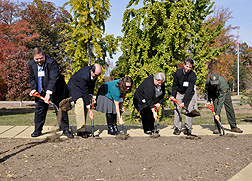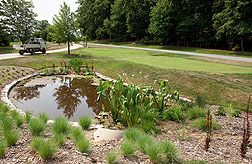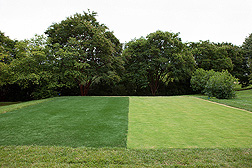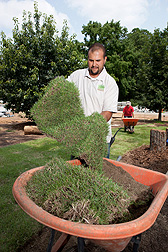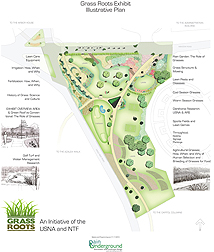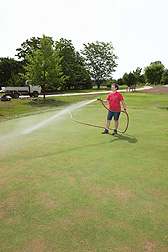The Greatest Show on Turf
Agricultural research is often thought of in terms of fresh produce, like lettuce, corn, apples, and other nutritious foodstuffs. However, turf is another agricultural commodity deserving of research and improvement.
Agricultural Research Service scientists are working diligently to improve turf grass as a commodity. Along with this research is a new program called “Grass Roots,” a 4-year initiative that focuses on turf grass—its uses, management, benefits, and value.
Research at Its Roots
At ARS’s U.S. National Arboretum, plant geneticist Scott Warnke and his colleagues are using molecular genetics to determine the genetic workings of turf grasses like creeping bentgrass. Creeping bentgrass is one of the species best adapted to use on golf course fairways and putting greens because of its tolerance to low mowing. Low mowing causes most other grasses to burn under the intensity of the summer sun.
Warnke, who is in the Arboretum’s Floral and Nursery Plants Research Unit in Beltsville, Maryland, and his collaborators at Rutgers University and the University of Massachusetts completed the first linkage map for creeping bentgrass.
“The new linkage map will help eventually in marker-assisted breeding of economically important traits, like disease resistance to dollar spot and brown patch, which are common diseases of bentgrass,” says Warnke. “This type of research will help scientists develop improved turf grass germplasm that requires less pesticide, fertilizer, and water. This germplasm will be released to plant breeders at public and private institutions for further development and eventual release of new cultivars.”
The genus Agrostis, commonly known as the bentgrasses, is an extremely diverse and highly outcrossing genus. Only 5 species of the more than 200 in the genus are used as turf grass in the United States: colonial (Agrostis capillaris), velvet (A. canina), dryland (A. castellana), redtop (A. gigantea), and creeping (A. stolonifera). These species have very different characteristics. One of the keys to improving important traits in A. stolonifera would be to transfer these traits from another species. For example, A. castellana is far better at withstanding drought and disease, but is less suitable for use as a golf turf than A. stolonifera.
This research, and other work similar to it, has led to the “Grass Roots” initiative, a collaborative effort between ARS’s U.S. National Arboretum and the National Turfgrass Federation. The program consists of five components: an outdoor interactive exhibit; extensive information on the Web that complements the outdoor exhibit; workshops, product demonstrations, and symposia; the development of the National Greenscape Corridor, a cooperative effort linking the National Mall, Arlington National Cemetery, and the National Arboretum; and a tabletop book titled “Personal Grass Roots,” featuring stories from many well-known people about their early childhood experiences with lawn mowing or groundskeeping and how this shaped their future.
|
|
Grass Roots Outdoors
The outdoor exhibit design was developed by a team of people led by head horticulturist Scott Aker, which included Arboretum staff and turf grass researchers. The design and the exhibit language were then reviewed by an industry advisory panel.
“The Arboretum began construction of the exhibit in November 2013, and it will open by the fall of 2014,” says research leader and plant geneticist Margaret Pooler.
The outdoor exhibit is a 1-acre space, adjacent to the Arboretum’s administration building and visitor center, located in Washington, D.C. There are 14 stations, including golf turf, irrigation, fertilization, maintenance equipment, lawn history, sports fields and lawn games, lawns of the future, turf diseases and pests, grass types, and a “green roof.”
|
|
The green roof station is the centerpiece of the exhibit and includes a welcome station that provides an overview of the “Grass Roots” exhibit. The station compares runoff between a conventional roof and a green roof—one that contains turf grass plants—and shows that the green roof absorbs and cleanses water and also cools the temperature underneath the structure.
A station called “Danthonia” will inform visitors about the development of a potentially new turf grass species and how science plays a major role in improving it. Danthonia spicata is a native grass common on the East Coast of the United States. Research on Danthonia is focused on its unique reproductive biology and its ability to tolerate low-fertility soils. “Future turf grasses will have to be more drought tolerant, pest resistant, and persistent under harsh environmental conditions, and Danthonia has all these traits,” says Warnke.
The irrigation station conveys a message any visitor can use: “Save water.” It features information to help consumers learn about smart water usage, including a display of different water-efficient sprinkler heads. “These tips can help visitors save water and result in healthier turf,” says Pooler.
The sports turf station will introduce visitors to the complexities of sports turf and provide space to play various lawn games like croquet and golf. Many people think of sports turf as just a large field of grass, but sports turf is a complex, highly engineered system that protects people and the environment. “Sports turf can act as a buffer between sports facilities and the underground water supply,” says Warnke. “It acts as a natural filtration system, taking in pollutants and nutrients before they reach the underground water table.”
National Greenscape Corridor
The greenscape corridor encompasses three distinct locations that display the different uses of turf: Arlington National Cemetery, the National Mall, and the U.S. National Arboretum.
Each location demonstrates a specific function. Arlington National Cemetery honors service men and women by providing a final resting place and quiet, grassy spaces for reflection and remembrance. The National Mall provides an expanse of turf for residents and visitors to play, assemble, or just enjoy a wonderful setting in the Nation’s Capital. The U.S. National Arboretum conducts the science of turf grass development and management and develops new technologies in the turf grass field.
|
|
Other locations in Washington, D.C., such as parks, schools, colleges, and golf courses, to name a few, could possibly become part of the National Greenscape Corridor, eventually linking popular tourist destinations through these common greenscapes.
“This initiative illustrates how we can connect ARS science to something that is familiar to just about every person in America.” says Pooler.—By Sharon Durham, Agricultural Research Service Information Staff.
This research is part of Pasture, Forage, and Rangeland Systems (#215) and Plant Genetic Resources, Genomics, and Genetic Improvement (#301), two ARS national programs described at www.nps.ars.usda.gov.
Scott Warnke is in the USDA-ARS Floral and Nursery Plants Research Unit, 10300 Baltimore Ave., Bldg. 010A, Beltsville, MD 20705-2350, (301) 504-8260.
"The Greatest Show on Turf" was published in the October 2014 issue of Agricultural Research magazine.








